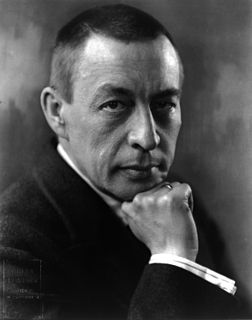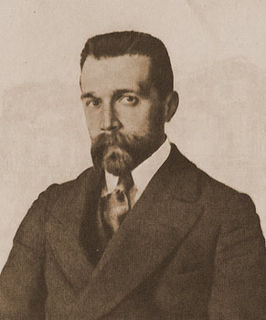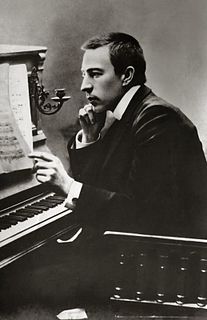
Sergei Vasilyevich Rachmaninoff was a Russian composer, virtuoso pianist, and conductor of the late Romantic period. The influence of Tchaikovsky, Rimsky-Korsakov, Balakirev, Mussorgsky, and other Russian composers is seen in his early works, later giving way to a personal style notable for song-like melodicism, expressiveness and rich orchestral colours.

The Rhapsody on a Theme of Paganini, Op. 43, is a concertante work written by Sergei Rachmaninoff for piano and orchestra, closely resembling a piano concerto, all in a single movement. Rachmaninoff wrote the work at his summer home, the Villa Senar in Switzerland, according to the score, from 3 July to 18 August 1934. Rachmaninoff himself, a noted interpreter of his own works, played the piano part at the piece's premiere on 7 November 1934, at the Lyric Opera House in Baltimore, Maryland, with the Philadelphia Orchestra conducted by Leopold Stokowski. Rachmaninoff, Stokowski, and the Philadelphia Orchestra made the first recording, on 24 December 1934, at RCA Victor's Trinity Church Studio in Camden, New Jersey. The English premiere on 7 March 1935 at Manchester Free Trade Hall also featured Rachmaninoff with The Hallé under Nikolai Malko.

Sergei Rachmaninoff's Piano Concerto No. 3 in D minor, Op. 30, was composed in the summer of 1909. The piece was premiered on November 28 of that year in New York City with the composer as soloist. The second performance of the concerto took place on January 16, 1910 and featured Gustav Mahler conducting. The work often has the reputation of being one of the most technically challenging piano concertos in the standard classical piano repertoire.
The Symphony No. 8 in C minor, Op. 65, by Dmitri Shostakovich was written in the summer of 1943, and first performed on November 4 of that year by the USSR Symphony Orchestra under Yevgeny Mravinsky, to whom the work is dedicated. It was named the 'Stalingrad Symphony' by the USSR.

Nikolai Yakovlevich Myaskovsky or Miaskovsky or Miaskowsky, was a Russian and Soviet composer. He is sometimes referred to as the "Father of the Soviet Symphony". Myaskovsky was awarded the Stalin Prize five times, more than any other composer.

The Piano Concerto No. 2 in C minor, Op. 18, is a concerto for piano and orchestra composed by Sergei Rachmaninoff between the autumn of 1900 and April 1901. The second and third movements were first performed with the composer as soloist on 2 December 1900. The complete work was premiered, again with the composer as soloist, on 9 November 1901, with his cousin Alexander Siloti conducting.
Written in memory of Tchaikovsky, Sergei Rachmaninoff's Trio élégiaque in D minor, Opus 9 is a piano trio begun on 5 October and completed on 15 December 1893. It was first performed in Moscow on 31 January 1894 with Rachmaninoff himself playing the piano part.

The Symphony No. 2 in E minor, Op. 27, is a symphony by the Russian composer Sergei Rachmaninoff, written in 1906–07. The premiere was conducted by the composer himself in Saint Petersburg on 8 February 1908. Its duration is approximately 60 minutes when performed uncut; cut performances can be as short as 35 minutes. The score is dedicated to Sergei Taneyev, a Russian composer, teacher, theorist, author, and pupil of Pyotr Ilyich Tchaikovsky. Alongside his Prelude in C-sharp minor, Piano Concerto No. 2 and Piano Concerto No. 3, and Rhapsody on a Theme of Paganini, this symphony remains one of the composer's best known compositions.
A London Symphony is the second symphony composed by Ralph Vaughan Williams. The work is sometimes referred to as Symphony No. 2, though the composer did not designate that name for the work. First performed in 1914, the original score of this four-movement symphony was lost and subsequently reconstructed. Vaughan Williams continued revisions of the work into its final definitive form, which was published in 1936.
Sergei Prokofiev set to work on his Piano Concerto No. 2 in G minor, Op. 16, in 1912 and completed it the next year. But that version of the concerto is lost; the score was destroyed in a fire following the Russian Revolution. Prokofiev reconstructed the work in 1923, two years after finishing his Piano Concerto No. 3, and declared it to be “so completely rewritten that it might almost be considered [Piano Concerto] No. 4.” Indeed its orchestration has features that clearly postdate the 1921 concerto. Performing as soloist, Prokofiev premiered this “No. 2” in Paris on 8 May 1924 with Serge Koussevitzky conducting. It is dedicated to the memory of Maximilian Schmidthof, a friend of Prokofiev's at the St. Petersburg Conservatory who had killed himself in 1913.

Russian composer Sergei Rachmaninoff's Symphony No. 1 in D minor, his Op. 13, was composed between January and October 1895 at his Ivanovka estate near Tambov, Russia. Despite its poor initial reception, the symphony is now seen as a dynamic representation of the Russian symphonic tradition, with British composer Robert Simpson calling it "a powerful work in its own right, stemming from Borodin and Tchaikovsky, but convinced, individual, finely constructed, and achieving a genuinely tragic and heroic expression that stands far above the pathos of his later music."
Sergei Rachmaninoff composed his Piano Concerto No. 1 in F♯ minor, Op. 1, in 1891, at age 18. He dedicated the work to Alexander Siloti. He revised the work thoroughly in 1917.
Sergei Rachmaninoff composed his Symphony No. 3 in A minor, Op. 44 between 1935 and 1936. The Third Symphony is considered a transitional work in Rachmaninoff's output. In melodic outline and rhythm it is his most expressively Russian symphony, particularly in the dance rhythms of the finale. What was groundbreaking in this symphony was its greater economy of utterance compared to its two predecessors. This sparer style, first apparent in the Rhapsody on a Theme of Paganini, enhances the emotional power of the work.

The Symphonic Dances, Op. 45, is an orchestral suite in three movements. Completed in 1940, it is Sergei Rachmaninoff's last major composition.
The Bells, Op. 35, is a choral symphony by Sergei Rachmaninoff, written in 1913. The words are from the poem The Bells by Edgar Allan Poe, very freely translated into Russian by the symbolist poet Konstantin Balmont. The traditional Gregorian melody Dies Irae is used frequently throughout the work. It was one of Rachmaninoff's two favorite compositions, along with his All-Night Vigil, and is considered by some to be his secular choral masterpiece. Rachmaninoff called the work both a choral symphony and (unofficially) his Third Symphony shortly after writing it; however, he would later write a purely instrumental Third Symphony at his new villa in Switzerland. Rachmaninoff dedicated The Bells to Dutch conductor Willem Mengelberg and the Concertgebouw Orchestra.

Piano Sonata No. 1 in D minor, Op. 28, is a piano sonata by Sergei Rachmaninoff, completed in 1908. It is the first of three "Dresden pieces", along with Symphony No. 2 and part of an opera, which were composed in the quiet city of Dresden, Germany. It was originally inspired by Goethe's tragic play Faust; although Rachmaninoff abandoned the idea soon after beginning composition, traces of this influence can still be found. After numerous revisions and substantial cuts made at the advice of his colleagues, he completed it on April 11, 1908. Konstantin Igumnov gave the premiere in Moscow on October 17, 1908. It received a lukewarm response there, and remains one of the least performed of Rachmaninoff's works.
Scherzo in D minor is Sergei Rachmaninoff's earliest surviving composition for orchestra, composed when he was a student at the Moscow Conservatory. It is quite short, taking between four and five minutes to play.

Prince Rostislav is a symphonic poem by Sergei Rachmaninoff. It was composed when he was a student at the Moscow Conservatory, and is one of his earliest surviving compositions for orchestra. A typical performance of the work lasts from sixteen to twenty minutes.
The Études-Tableaux, Op. 33, is the first of two sets of piano études composed by Sergei Rachmaninoff. They were intended to be "picture pieces", essentially "musical evocations of external visual stimuli". But Rachmaninoff did not disclose what inspired each one, stating: "I do not believe in the artist that discloses too much of his images. Let [the listener] paint for themselves what it most suggests." However, he willingly shared sources for a few of these études with the Italian composer Ottorino Respighi when Respighi orchestrated them in 1930.
The Piano Concerto in C minor, Op. 12, is a three-movement composition for piano and orchestra by French composer Gabriel Pierné. The piece was completed in early 1887, shortly after Pierné returned to Paris from a three year stay in Rome.









